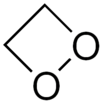1,2-Dioxetane
| |||
| Names | |||
|---|---|---|---|
| IUPAC name
1,2-Dioxetane | |||
| Other names
1,2-Dioxacyclobutane | |||
| Identifiers | |||
| 6788-84-7 | |||
| 3D model (Jmol) | Interactive image Interactive image | ||
| ChemSpider | 108850 | ||
| PubChem | 122029 | ||
| |||
| |||
| Properties | |||
| C2H4O2 | |||
| Molar mass | 60.05 g·mol−1 | ||
| Except where otherwise noted, data are given for materials in their standard state (at 25 °C [77 °F], 100 kPa). | |||
| | |||
| Infobox references | |||
The chemical substance 1,2-dioxetane (1,2-dioxacyclobutane) is an heterocyclic organic compound with formula C2O2H4, containing a ring of two adjacent oxygen atoms and two adjacent carbon atoms. It is therefore an organic peroxide, and can be viewed as a dimer of formaldehyde (COH2).
In the 1960s, biochemists discovered that some derivatives of 1,2-dioxetane have a fleeting existence as intermediates in the reactions responsible for the bioluminescence in fireflies, glow-worms and other luminescent creatures. The hypothesis could not be proved because these four-membered cyclic peroxides are quite unstable. Then in 1968 the first example of a stable dioxetane derivative was made at the University of Alberta in Edmonton: 3,3,4-trimethyl-1,2-dioxetane, prepared as a yellow solution in benzene. When heated to 333 K, it decomposed smoothly (rather than explosively, as many peroxides do) to acetone and acetaldehyde with the emission of pale blue light.[1]
The second example of a dioxetane derivative was made shortly after: the symmetrical compound 3,3,4,4-tetramethyl-1,2-dioxetane, obtained as pale yellow crystals that sublimed even when kept in the refrigerator. Benzene solutions of this compound also decomposed smoothly with the emission of blue light. By adding compounds that normally fluoresce in UV light the colour of the emitted light could be altered.[2]
The luminescence of glowsticks and luminescent bangles and necklaces involves 1,2-dioxetanedione (C2O4), another dioxetane derivative that decomposes to carbon dioxide.
Other dioxetane derivatives are used in clinical analysis, where their light emission (which can be measured even at very low levels) allows chemists to detect very low concentrations of body fluid constituents.[3]
See also
References
- ↑ Luminescence in the thermal decomposition of 3,3,4-trimethyl-1,2-dioxetane, Canadian Journal of Chemistry, Volume 47, p 709 (1969), K.R.Kopecky and C. Mumford
- ↑ Preparation and Thermolysis of some 1,2-dioxetanes, Canadian Journal of Chemistry, Volume 53, pa 1103 (1975), K.R. Kopecy et al.
- ↑ US Patent No. 5,330,900 to Tropix Inc.

